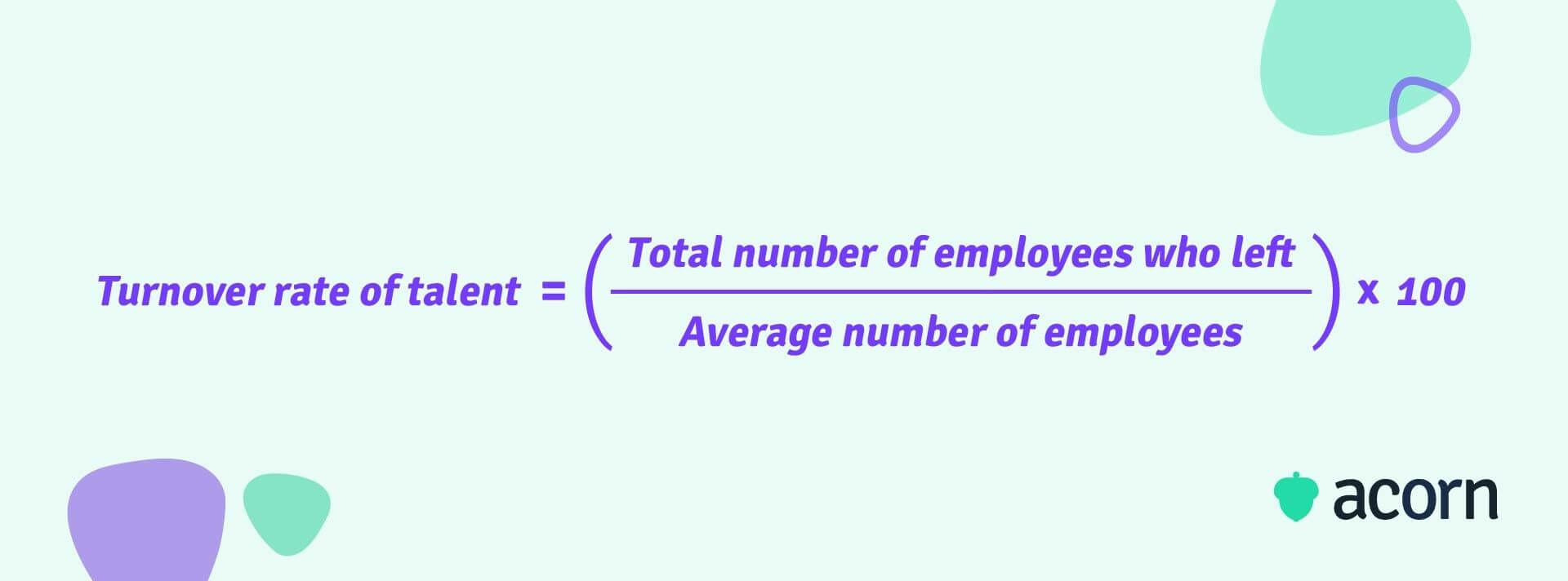How to Calculate & Analyse the Turnover Rate of Talent in Your Organisation
Reading Time:

Lead the pack with the latest in strategic L&D every month— straight to your inbox.
SubscribeCalculating your turnover rate of talent is the first step to understanding the health of your workplace.
All organisations will experience a turnover of talent, it’s just a question of whether they have a healthy turnover rate. When employees leave your company, it can be due to career development, job dissatisfaction, or personal reasons.
This is where your turnover rate of talent comes in. In this guide we’ll discuss how you can go about calculating employee turnover rate, and how you can use it as a starting metric in understanding the underlying issues contributing to high turnover.
What is turnover rate of talent?
Talent turnover rate is an HR metric that measures the rate at which talent leaves an organisation, creating vacant positions. This is also known as employee turnover, and can be voluntary or involuntary. It’s a metric that can be used in identifying and evaluating underlying issues and areas for improvement in talent management and the retention of top talent.
The cost of high talent turnover rates
Regardless of what your employee turnover rate is, or whether employees leave by choice or are let go, it will have an impact on your business. Said impact can come in the form of both direct and indirect costs to the business.
Direct costs are the tangible, measurable expenses to a business as a result of employee turnover. These include:
- Recruitment costs, which cover anything and everything from advertisements for job roles, the interviewing process, or possibly even security clearances for potential new hires. Studies show that hiring new employees can cost anything between $4,000 to $8,000, which, if done frequently, will really hit your bottom line.
- Overhead costs, such as administrative expenses for HR professionals and hiring managers during the hiring, onboarding, and training processes.
- Training costs while onboarding new hires. This includes training on-job duties, processes, policies, and company culture.
On the other hand, indirect costs refer to the intangible costs that negatively impact a business, such as:
- Decreased productivity as a direct result of increased time to proficiency in new employees as they learn their new responsibilities, which impacts time to productivity. Remaining employees and managers may also be asked to take on additional job duties while a replacement is still being found, taking time away from their usual tasks.
- Lost organisational knowledge when employees leave with knowledge and expertise only they possessed, which can be difficult to replace and prevents businesses from carrying out their usual processes.
- Decreased employee morale, perhaps because of a lack of workplace camaraderie if turnover is quick, or remaining employees having to take on extra work, leading to increased stress and decreased job satisfaction.
- Negative brand reputation among employees and customers. Employees and potential employees may feel the company is toxic to work for, making it harder to hire and retain talent, while customers may also view the business as toxic or incompetent and choose to purchase products and services elsewhere.
So, what does this all mean? Well, while your employee turnover rate shows how many employees exit the business, it doesn’t reveal the underlying causes behind why talent chooses to leave. Of course, turnover is to be expected, and you can have a healthy turnover of talent rate. Gallup says that a healthy turnover rate is around 10%. But it’s also important to use your turnover rate alongside other HR metrics to understand what may be causing voluntary turnover and identify areas to improve retention.
What are the challenges of measuring employee turnover?
Some might argue that measuring employee turnover rates only highlights problems of the past rather than the current state of the organisation—and they would be right. But that doesn’t make employee turnover a useless metric.
While relying solely on a one-time measurement of your employee turnover rate isn’t useful, continually measuring over time can reveal trends and patterns in your workforce that point to the underlying drivers of employee turnover. Of course, this alone won’t reveal the underlying causes, which is why you still need to combine your employee turnover rate with other HR and engagement metrics to help analyse and explain the data.
How to calculate talent turnover rate
When you calculate employee turnover rate, the first things you need to define are:
- The specific group you’re measuring turnover for (this could be the whole organisation or a specific department)
- The time period you’re measuring for (such as a specific year or quarter).
To calculate employee turnover rate, you just need to divide the total number of employees who left during a certain period by the average number of employees who were employed during that same time. Then you can multiply the answer to get a percentage.

So, if you want to measure the turnover rate for your organisation, which had 100 team members on average over the financial year, and you had 10 staff leave who resigned, retired, or were made redundant over that year, then your formula will be:

Maybe you want to measure a specific department’s turnover. Let’s say your development team consists of an average of 35 employees over a quarter, but three employees left during that time. Your average turnover rate will be:

These numbers don’t reveal much on their own, other than the fact that 10% of employees left your organisation over the course of the financial year, or 8.57% of developers left your development team in a quarter. What you need to do is analyse your staff turnover to understand why turnover happens and what can be done to improve your employee retention rate.
Keep in mind that what’s considered a “good” employee turnover rate varies across different industries and job roles, so what seems abnormally high in one company might actually be standard for their particular industry. For example, three out of a 35-person development team resigning in a quarter might not seem so bad at face value, but we’ll give you a few scenarios to consider.
- All three developers were let go within a year of starting at your organisation, signalling an issue with recruitment or development processes—basically, that neither are robust nor aligned with the development team’s capability needs
- Two of those developers resigned in the same month, and exit interviews flagged that they felt under-supported by their managers. In case we need to make that really clear, said turnover rate shows an issue with culture and management.
- The developers who left were all tenured employees exploring new opportunities; for example, your head of development and product manager. All had successors prepped and ready to go, so no ramifications were felt.
The point we’re trying to make is that one percentage figure could look good or bad without context. This is where different HR metrics come into play. You can use different metrics to analyse turnover rates and their underlying causes, allowing you to identify and action improvements to the workplace. This way you can determine the factors contributing to overall employee satisfaction, and how they might be affecting employee turnover rates.
Strategies for reducing talent turnover rates
Ideally, organisations want to reduce their overall turnover rate and increase employee retention rates. This way, you keep organisational capabilities and expertise, build stronger company culture, and save on recruitment costs.
The first step to doing this is analysing the cause of your company’s turnover to identify areas for improvement. You can do this with other metrics, feedback and evaluations that look into employee engagement and workplace culture, allowing you to address specific issues impacting your average employee turnover rate. There are a few strategies organisations can utilise to do this.
- Conduct exit interviews to understand why employees are leaving the organisation. You can use this feedback to identify improvement areas and develop actionable steps to address them.
- Offer opportunities for career growth and development so your employees feel valued and motivated to stay in their roles. 94% of employees say they would stay with companies longer if they were provided with L&D programs. You can use a performance learning management system (PLMS) to manage learning opportunities as well as the affect of learning on employee performance.
- Improve the onboarding process to reduce new hire turnover rate and improve time to proficiency. This way, employees will feel more at ease in their roles earlier on, with clear expectations of their responsibilities.
- Offer competitive compensation and benefits to keep employees for longer periods of time or prevent them from job-hopping.
- Engage employees in the organisation, by allowing employees to have greater involvement in decision-making, rewarding high-performers, and providing a sense of strategic purpose. This way, employees will feel they have and provide value to the business, rather than just being another cog in the machine.
- Foster a positive work environment. No one wants to work in a toxic company culture or sacrifice their work-life balance, so you should work on building a positive culture of continuous learning and open communication where staff feel supported and valued.
Key takeaways
Turnover rate of talent is an important starting metric to understand why employees leave an organisation. Alongside metrics looking into engagement, motivation, and capabilities, calculating employee turnover helps businesses identify underlying causes driving turnover and develop retention strategies to address their voluntary turnover rate.
When you aim to reduce high employee turnover, you need to remember that creating a positive working environment for employees is the most crucial step in retaining talent. This includes offering opportunities for career development, open communication and collaboration, and involving employees in business strategy to provide and positive working environment where employees feel valued.